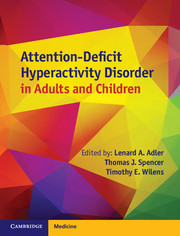40 results
Strategies used for the COVID-OUT decentralized trial of outpatient treatment of SARS-CoV-2
-
- Journal:
- Journal of Clinical and Translational Science / Volume 7 / Issue 1 / 2023
- Published online by Cambridge University Press:
- 07 November 2023, e242
-
- Article
-
- You have access
- Open access
- HTML
- Export citation
Precision oncology using ex vivo technology: a step towards individualised cancer care?
-
- Journal:
- Expert Reviews in Molecular Medicine / Volume 24 / 2022
- Published online by Cambridge University Press:
- 03 October 2022, e39
-
- Article
-
- You have access
- Open access
- HTML
- Export citation
Toward operationalizing deficient emotional self-regulation in newly referred adults with ADHD: A receiver operator characteristic curve analysis
-
- Journal:
- European Psychiatry / Volume 63 / Issue 1 / 2020
- Published online by Cambridge University Press:
- 24 February 2020, e21
-
- Article
-
- You have access
- Open access
- HTML
- Export citation
Great Lakes Copper and Shared Mortuary Practices on the Atlantic Coast: Implications for Long-Distance Exchange during the Late Archaic
-
- Journal:
- American Antiquity / Volume 84 / Issue 4 / October 2019
- Published online by Cambridge University Press:
- 02 September 2019, pp. 591-609
- Print publication:
- October 2019
-
- Article
- Export citation
Towards operationalising internal distractibility (Mind Wandering) in adults with ADHD
-
- Journal:
- Acta Neuropsychiatrica / Volume 29 / Issue 6 / December 2017
- Published online by Cambridge University Press:
- 17 January 2017, pp. 330-336
-
- Article
- Export citation
List of Contributors
-
- Book:
- Journal of Medieval Military History
- Published by:
- Boydell & Brewer
- Published online:
- 25 May 2021
- Print publication:
- 15 October 2015, pp 277-280
-
- Chapter
- Export citation
De Re Militari and the Journal of Medieval Military History
-
- Book:
- Journal of Medieval Military History
- Published by:
- Boydell & Brewer
- Published online:
- 25 May 2021
- Print publication:
- 15 October 2015, pp 287-287
-
- Chapter
- Export citation
Frontmatter
-
- Book:
- Journal of Medieval Military History
- Published by:
- Boydell & Brewer
- Published online:
- 25 May 2021
- Print publication:
- 15 October 2015, pp i-iv
-
- Chapter
- Export citation
List of Illustrations and Table
-
- Book:
- Journal of Medieval Military History
- Published by:
- Boydell & Brewer
- Published online:
- 25 May 2021
- Print publication:
- 15 October 2015, pp vi-vi
-
- Chapter
- Export citation
Journal of Medieval Military History 1477–545X
-
- Book:
- Journal of Medieval Military History
- Published by:
- Boydell & Brewer
- Published online:
- 25 May 2021
- Print publication:
- 15 October 2015, pp 281-286
-
- Chapter
- Export citation
Contents
-
- Book:
- Journal of Medieval Military History
- Published by:
- Boydell & Brewer
- Published online:
- 25 May 2021
- Print publication:
- 15 October 2015, pp v-v
-
- Chapter
- Export citation

Journal of Medieval Military History
- Volume XIII
-
- Published by:
- Boydell & Brewer
- Published online:
- 25 May 2021
- Print publication:
- 15 October 2015
Copyright page
-
- Book:
- Attention-Deficit Hyperactivity Disorder in Adults and Children
- Published online:
- 05 February 2015
- Print publication:
- 08 January 2015, pp iv-iv
-
- Chapter
- Export citation
Contents
-
- Book:
- Attention-Deficit Hyperactivity Disorder in Adults and Children
- Published online:
- 05 February 2015
- Print publication:
- 08 January 2015, pp v-vi
-
- Chapter
- Export citation
Attention-Deficit Hyperactivity Disorder in Adults and Children - Title page
-
-
- Book:
- Attention-Deficit Hyperactivity Disorder in Adults and Children
- Published online:
- 05 February 2015
- Print publication:
- 08 January 2015, pp iii-iii
-
- Chapter
- Export citation
Index
-
- Book:
- Attention-Deficit Hyperactivity Disorder in Adults and Children
- Published online:
- 05 February 2015
- Print publication:
- 08 January 2015, pp 378-392
-
- Chapter
- Export citation

Attention-Deficit Hyperactivity Disorder in Adults and Children
-
- Published online:
- 05 February 2015
- Print publication:
- 08 January 2015
Attention-Deficit Hyperactivity Disorder in Adults and Children - Half title page
-
- Book:
- Attention-Deficit Hyperactivity Disorder in Adults and Children
- Published online:
- 05 February 2015
- Print publication:
- 08 January 2015, pp i-ii
-
- Chapter
- Export citation
Short-Term Cardiovascular Effects of Mixed Amphetamine Salts Extended Release in Children and Adolescents With Oppositional Defiant Disorder
-
- Journal:
- CNS Spectrums / Volume 10 / Issue S15 / October 2005
- Published online by Cambridge University Press:
- 07 November 2014, pp. 31-38
-
- Article
- Export citation
Long-Term Safety and Effectiveness of Mixed Amphetamine Salts Extended Release in Adults With ADHD
-
- Journal:
- CNS Spectrums / Volume 10 / Issue S20 / December 2005
- Published online by Cambridge University Press:
- 07 November 2014, pp. 16-25
-
- Article
- Export citation

